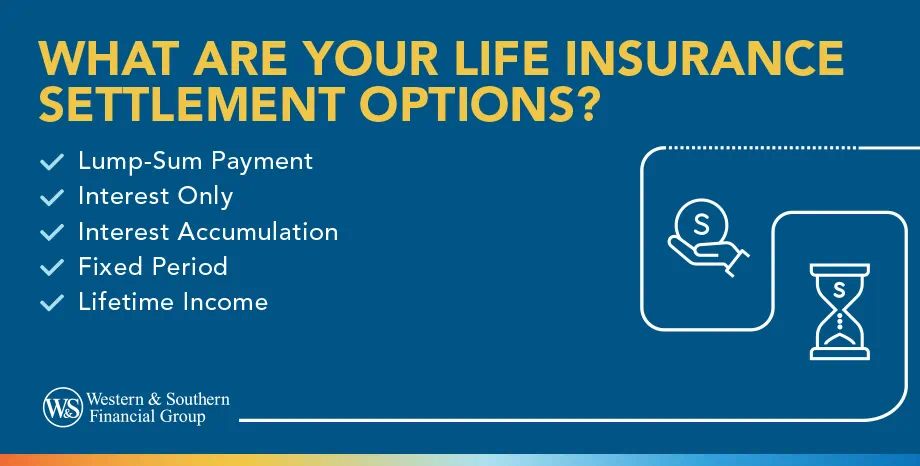Table of Contents
Table of Contents


Key Takeaways
- Life insurance death benefits can be disbursed through various settlement options.
- Common options include lump-sum payment, interest income, interest accumulation, fixed period income, and lifetime income.
- Lump-sum payment provides full access to the death benefit at once.
- Interest income and accumulation options offer flexibility in receiving funds.
- Lifetime income options provide regular payments for the beneficiary's lifetime.
Life insurance can provide money to your loved ones at a critical time. When an insured person dies, their beneficiary is then eligible to receive the policy's death benefit. Some people may think of a life insurance death benefit as a lump-sum payment, but insurers typically offer a variety of life insurance settlement options. Here's some information on how death benefits typically work and some of the settlement options that may be available to you as the beneficiary.
How Does a Life Insurance Death Benefit Work?
In rare cases, the policy owner might specify which life insurance settlement options they want to provide for beneficiaries, and they may even restrict when beneficiaries can receive funds. But in most cases, beneficiaries have options, and you can select the option that works most appropriately for your needs.
Tip
A death benefit can be a valuable asset, and insurers provide various options for disbursing payments after death.
How Does a Life Insurance Settlement Work?
When the insured person of a life insurance policy dies, their beneficiary or beneficiaries can receive the policy’s death benefit (the coverage amount for which the person was insured). Some of the most common life insurance settlement options include receiving a lump sum payment, interest earnings only (with full or partial withdrawals made later), regular payments over a fixed period of time and life only payments for the rest of one’s life (based on age).
A beneficiary also may choose a lifetime income with period certain option in which the insurer pays out income for the person’s whole life or the period certain (e.g., 10 years), whichever is longer. One other option is to leave the death benefit with the insurance company in an interest-bearing account to continue to grow in value, with full or partial withdrawals to be made whenever the beneficiary chooses.
Make smart choices in life insurance settlements. Get a Life Insurance Quote
Common Life Insurance Settlement Options
There are common settlement options that life insurance companies typically offer. In addition to choosing from the options below, you can often customize the payment structure (other than lump-sum arrangements) and may be able to receive funds monthly, quarterly or annually. You should keep in mind that interest that is earned or paid out as part of a life insurance settlement option is taxable as regular income when received.
Lump-Sum Payment
A lump-sum payment is perhaps the easiest to understand. With this option, you receive the entire death benefit as a one-time payment. This gives you full access to the death benefit, and you can spend the money as you choose. This may enable you to pay off debts such as a mortgage. You can also save or invest this money after receiving the lump-sum payment.
Interest Only
With an interest income option, the insurance company holds the principal of the death benefit and pays you the interest earned. Any interest earnings would be paid out to you, and you can typically take full or partial withdrawals at almost any time if you need more money. This option may make sense if you only need a small amount of income from the death benefit.
Interest Accumulation
If you don't need money immediately, you can leave the death benefit with the insurer in an interest-bearing account. Any interest earnings stay in that account, and the monetary value would continue to grow with compound interest. You'll still have access to the funds and typically can make full or partial withdrawals when you choose.
Fixed Period
Instead of taking everything at once, you are able to receive the death benefit over a specified length of time, such as 20 years. That option may make sense if you have predictable expenses, such as mortgage payments, that end at a known date. Those regular payments can also simulate an income, helping to fill the gap that might arise when the deceased stops receiving income. Any remaining funds with the insurance company earn interest and are paid out with the regular payments.
Lifetime Income
Lifetime income is commonly referred to as life only payments. You can receive payments that are designed to last for the rest of your life (based primarily on your age). This approach may help to prevent you from spending the entire death benefit prematurely, and it could help ensure that you have regular income. Once this is set up, you typically cannot change the payment or take additional withdrawals.
Lifetime Income With Period Certain
Life only payments end after the death of the insured, so the balance of the settlement amount is left with the insurer. When choosing the lifetime income with period certain option, the insurance company pays out income for your whole life or the period certain — whichever is longer. Please also note that if the owner dies in two years, the period certain may not pay out the full amount of the initial benefit.
The Bottom Line
Receiving a life insurance death benefit can be a major life event, and understanding life insurance features can be tricky. In some cases, a lump-sum payment may be what you need most. But sometimes, other options may work better by providing ongoing income, flexibility or other benefits. Consider talking with a financial representative to discuss which settlement options may be right for you.
Make informed decisions and secure your financial future. Get a Life Insurance Quote











































